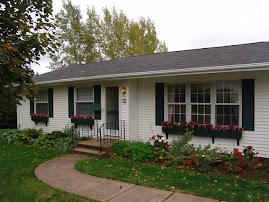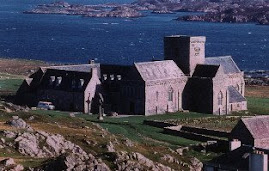




Friday began with a visit to yet another ruined 12th century castle, Donnottar in Stonehaven. This one, like the others we have seen, was situated on a promontory above the ocean, in this case the North Sea. We drove from the B&B to the car park for the castle tour. Then we walked about a quarter of a mile down a hill and back up to the castle. You can easily see why this place was chosen as the location of a fort. (By the way, I have learned that a castle is a fort, a defensive structure, and some castles include residences beyond barracks for the troops. All the castles we have seen so far seem to be both fort and residence.) Among the ruins was a chapel that was part of the castle set-up from early on, and we discovered that a chapel had been constructed on that site in the 5th or 6th century. So before this location became a place of power for earls and the kings they served, it was a place of worship and a center for early Christian missionaries. I think pre-Christian people worshiped there also.
Once we had thoroughly perused the remains, we set off north to Aberdeen to find the church where Samuel Seabury was consecrated the first Bishop of the Episcopal Church in the United States. I knew Seabury had been consecrated in Aberdeen, but I hadn’t had time before we left to look up the exact location. I naively thought that there would be some mention of the consecration in guidebooks, but we couldn’t find anything. So, being a librarian, Tom suggested we search out a library and see if we could find something there. After driving around a bit, we finally found a parking space and set off to see what we could find. Rather amazingly, when we had walked only about four blocks, there on our left was the city library. We went in on the first level which contained many computers. When Tom explained what we wanted, the librarian directed us to the Adult Book Section (tsk, tsk, not that kind of adult books) of the library on the second floor. From there we were directed up one more level to the local information reference section. While I waited for one of the librarians to help me, Tom decided to set off on his own to see if he could uncover anything of note. Using the old-fashioned card catalog method of searching for information, he found a book that contained some references to the consecration. Meanwhile the librarian brought me two other books that also gave us a lot of information. Between us we found out that Samuel Seabury had gone to Canterbury, England, in 1784 to ask if the English bishops would consecrate him, but they were unable to accommodate him because he would not swear an Oath of Allegiance to the Crown as part of the consecration liturgy.
So Seabury got himself up to Scotland, and three bishops there consecrated him; however, Seabury was not consecrated in a church building. The Rt. Rev. John Skinner, Bishop of Aberdeen and the rector of St. Andrew’s Scottish Episcopal Church, agreed to work with Seabury. At that time the congregation was meeting in Skinner’s home. Thus it was that Skinner and two other bishops gathered in the upper room of the Skinner home to consecrate Samuel Seabury the first Bishop of the Americas. Some years later the tenement that contained the Skinner home, was torn down to make way for a new wing of Marischal College. A plaque was made to commemorate the location of the consecration and placed on a wall of the college. Once we had found all this out, Tom and I set off to locate the College and the plaque. With the help of a nice man who took pity on us as we wandered around in circles with a little map in our hands, we made it to the college only to find out that it was being completely remodeled and no one but the destruction/construction crews were allowed inside. So, in order to not go away empty handed, we took a picture of the corner of the college where the house used to be. It felt good to stand in that spot and think about all that Seabury had gone through to be consecrated and to think that we stand in that long line of Episcopalians.
For those of you reading this who are not Episcopalians, here’s a little history of the Episcopal Church and Samuel Seabury. Before and during the War for Independence, aka the Revolutionary War, the Church of England in the colonies was governed from England, and the men who wanted to be priests had to sail to England to be ordained. When the colonies became the United States of American and severed their relationship with the English government, it became clear to the leaders of the church that they needed to set up an institution that was independent of England. In order to be independent they needed their own bishops primarily to ordain new priests. So a group of clergy gathered in Ridgefield, Connecticut, at what is now known as Glebe House, to elect the first bishop. Samuel Seabury was a priest of the Church of England in Connecticut before and during the War for Independence. He was a loyal Tory but chose to stay in the Untied States following the end of the war. He did not attend the meeting in Ridgefield but nonetheless was elected bishop.
I think that is quite enough for now. I’ll be back with some information about St. Andrew’s Cathedral in Aberdeen. Peace and love, Jane.



No comments:
Post a Comment